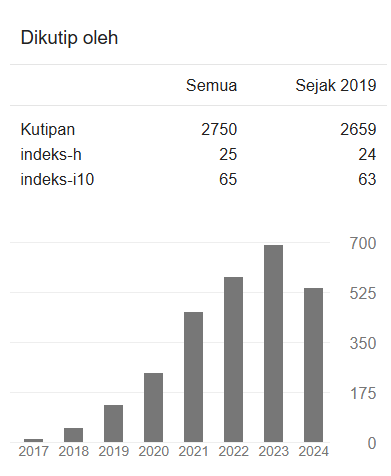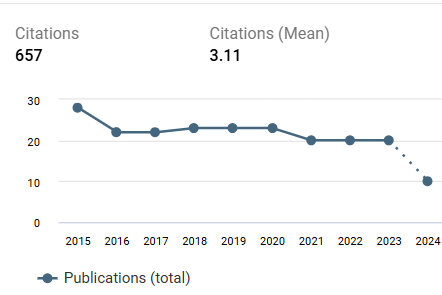Augmented reality based android application for introduction of pneumatic hydraulic components
DOI:
https://doi.org/10.22219/jinop.v10i2.34733Keywords:
Augmented Reality, Pneumatic Hydraulic, QR Code, Marker, FeasibilityAbstract
This study focuses on the utilization of augmented reality (AR) to enable comprehensive visualization of objects. Its primary objective is to develop and evaluate an AR application as a medium for introducing pneumatic hydraulic components. The research method employs a development research approach, following the assessment, design, development, implementation, and evaluation steps proposed by Lee and Owens. The feasibility of the product is determined through various assessments, including black box testing, validation by media experts, validation by content experts, and evaluation of initial user response. The outcome of this study is application software incorporating AR technology for the purpose of introducing pneumatic hydraulic components, along with a corresponding workbook. Whereas the application is compatible with the Android operating system and utilizes QR codes as markers for augmented reality objects, which are conveniently included within the workbook. Performance testing reveals that all application functions perform exceptionally well according to black box testing. Furthermore, the content expert feasibility assessment yields results categorized as “Good,” while both the media expert feasibility and initial user response tests indicate “Very Good” outcomes.
Downloads
References
Agarwal, P., & Alam, M. (2023). Knowledge Mapping of Human Activity Recognition Techniques for Assistive Living. International Journal of Sensors, Wireless Communications and Control, 13(4), 203–225. https://dl.acm.org/doi/10.1145/3494998
Arief, U., Wibawanto, H., & Nastiti, A. (2018). Augmented Reality Technology for Vocational Education the Disruption Era. International Conference on Indonesian Technical Vocational Education and Association (APTEKINDO 2018), 201(Aptekindo), 73–76. https://doi.org/10.2991/aptekindo-18.2018.16
Arsyad.A. (2019). Media Pembelajaran, 1st ed (1st ed.). PT RajaGrafindo Persada. https://www.rajagrafindo.co.id/produk/media-pembelajaran/
Asún, R. A., Rdz-Navarro, K., & Alvarado, J. M. (2016). Developing Multidimensional Likert Scales Using Item Factor Analysis: The Case of Four-point Items. Sociological Methods and Research, 45(1), 109–133. https://doi.org/10.1177/0049124114566716
Direktorat Pembinaan SMA. (2010). Panduan Pengembangan Bahan Ajar Berbasis TIK. Kementerian Pendidikan Nasional Direktorat Jenderal Manajemen Pendidikan Dasar Dan Menengah. https://fliphtml5.com/rxesx/vcym/PANDUAN_PENGEMBANGAN_BAHAN_AJAR_BERBASIS_TIK/
El Kabtane, H., El Adnani, M., Sadgal, M., & Mourdi, Y. (2018). Toward an occluded augmented reality framework in E-learning platforms for practical activities. Journal of Engineering Science and Technology, 13(2), 394–408. https://www.researchgate.net/publication/322066628_
Faith M. (2019). Mobile augmented reality learning objects in higher education. Research in Learning Technology, 27(1–10), 1–10. https://doi.org/10.25304/rlt.v27.2133
Garzón, J. (2021). An overview of twenty-five years of augmented reality in education. Multimodal Technologies and Interaction, 5(7). https://doi.org/10.3390/mti5070037
Guth, L., Söbke, H., Londong, J., Lingnau, A., & Hornecker, E. (2021). An Augmented Reality-supported Facility Model in Vocational Training. Proceedings of DELFI Workshops 2021 - 13.09.2021At: Dortmund (Online), Deutschland, 13, 15. https://www.researchgate.net/profile/Heinrich-Soebke/publication/355973305_
Hallmann, J., Stechert, C., & Ahmed, S. I. U. (2023). Supporting Student Laboratory Experiments With Augmented Reality Experience. Proceedings of the Design Society, 3(July), 3235–3244. https://doi.org/10.1017/pds.2023.324
Hamidi, H., & Chavoshi, A. (2018). Analysis of the essential factors for the adoption of mobile learning in higher education: A case study of students of the University of Technology. Telematics and Informatics, 35(4), 1053–1070. https://doi.org/10.1016/j.tele.2017.09.016
Hasanah Lubis, L., Febriani, B., Fitra Yana, R., Azhar, A., & Darajat, M. (2023). The Use of Learning Media and its Effect on Improving the Quality of Student Learning Outcomes. International Journal Of Education, Social Studies, And Management (IJESSM), 3(2), 7–14. https://doi.org/10.52121/ijessm.v3i2.148
Hatmojo, Y. I., & Azis, S. M. (2021). Development Mobile Application Android Based for Sensor and Transducer. Journal of Physics: Conference Series, 2111(1). https://doi.org/10.1088/1742-6596/2111/1/012010
Herawati A, Suwara, I.P., Hartanti, E. (2014). Pengaruh Media Pembelajaran Berbasis Augmented Reality terhadap Hasil Belajar siswa. 5(April). https://www.researchgate.net/profile/Iwan-Permana-Suwarna/publication/275225461_
Iatsyshyn, A. V., Kovach, V. O., Romanenko, Y. O., Deinega, I. I., Iatsyshyn, A. V., Popov, O. O., Kutsan, Y. G., Artemchuk, V. O., Burov, O. Y., & Lytvynova, S. H. (2020). Application of augmented reality technologies for preparation of specialists of new technological era. CEUR Workshop Proceedings, 2547(March 2020), 181–200. https://www.researchgate.net/publication/339944436_
Iqbal, M. Z., & Campbell, A. G. (2021). From luxury to necessity: Progress of touchless interaction technology. Technology in Society, 67, 101796. https://doi.org/10.1016/j.techsoc.2021.101796
Istanto, D. W. (2018). Strategi Penulisan Skripsi, Tesis, Disertasi Bidang Pendidikan. In UNY Press. https://onesearch.id/Record/IOS4895.slims-56719
Jamian, S., Salim, S. N. S., Kamarudin, M. N., Zainon, M., Syed Mohamad, M. S., Abdullah, L., & Hanafiah, M. A. M. (2020). Review on controller design in pneumatic actuator drive system. Telkomnika (Telecommunication Computing Electronics and Control), 18(1), 332–342. https://doi.org/10.12928/TELKOMNIKA.V18I1.12626
Katona, B., Venkataragavan, J., Nina, E., Ulrika, B., & Björn, O. (2023). Use of Visual Learning Media to Increase Student Learning Motivation. World Psychology, 1(3), 89–105. https://doi.org/10.55849/wp.v1i3.381
Köhler, T., & Hariyanto, D. (2020). A Web-Based Adaptive E-learning Application for Engineering Students : An Expert-Based Evaluation. International Journal of Engineering Pedagogy (IJEP), 10(2), 60–71. https://doi.org/10.3991/ijep.v10i2.11834
Kustija, J., Ana, A., & Jayanto, N. D. W. I. (2021). Web-based and thinvnc remote laboratory implementation to support students skills in mechatronics course to face the industrial revolution 4.0. Journal of Engineering Science and Technology, 16(2), 1800–1813. https://jestec.taylors.edu.my/Vol%2016%20issue%202%20April%202021/16_2_63.pdf
Law, R., Chan, I. C. C., & Wang, L. (2018). A comprehensive review of mobile technology use in hospitality and tourism. Journal of Hospitality Marketing and Management, 27(6), 626–648. https://doi.org/10.1080/19368623.2018.1423251
Lin, P. Y., Wu, W. C., & Yang, J. H. (2021). A QR code-based approach to differentiating the display of augmented reality content. Applied Sciences (Switzerland), 11(24). https://doi.org/10.3390/app112411801
Lubis, D. D. (2023). Using Digital Learning Media to Increase Student Creativity in Solving Mathematics Problems. EDUCTUM: Journal Research, 2(5), 16–18. https://doi.org/10.56495/ejr.v2i5.462
Maryadi, T. H. T., Sukisno, T., Chandra, A. N., & Atmoko, A. W. (2019). Augmented Reality-Based Instructional Media for Electrical Power Protection Learning. Journal of Physics: Conference Series, 1387(1). https://doi.org/10.1088/1742-6596/1387/1/012015
Maxim, B. R., & Pressman, R. S. (2014). Software Engineering: A Practitioner’s Approach (8th ed.). McGraw-Hill. https://books.google.co.id/books?hl=en&lr=&id=bL7QZHtWvaUC&oi=fnd&pg=PA1&dq=Maxim,+B.+R.,+%26+Pressman,+R.+S.+(2014).+Software+Engineering:+A+Practitioner%E2%80%99s+Approach+(8th+ed.).
Mensah, J. (2019). Sustainable development: Meaning, history, principles, pillars, and implications for human action: Literature review. Cogent Social Sciences, 5(1). https://doi.org/10.1080/23311886.2019.1653531
Monika, B, J., & Sunita, D. (2023). Scope and Challenges of Multimedia in Education Sector. International Journal For Multidisciplinary Research, 5(3). https://doi.org/10.36948/ijfmr.2023.v05i03.3868
Mumu, J., Tanujaya, B., Charitas, R., & Prahmana, I. (2022). Likert Scale in Social Sciences Research: Problems and Difficulties. FWU Journal of Social Sciences, 16(4), 89–101. https://doi.org/10.51709/19951272/Winter2022/7
Puspitarini, Y. D., & Hanif, M. (2019). Using Learning Media to Increase Learning Motivation in Elementary School. Anatolian Journal of Education, 4(2), 53–60. https://doi.org/10.29333/aje.2019.426a
Raharja, P. A., & Pramudya, B. Z. (2022). Evaluasi Usability Aplikasi Augmented Reality Morphfun Menggunakan System Usability Scale. Multinetics, 8(2), 122–130. https://doi.org/10.32722/multinetics.v8i2.4702
Sanjaya, W. (2015). Penelitian Pendidikan: Metode, Pendekatan, dan Jenis (3th ed.). Pt Fajar Interpratama Mandiri. https://books.google.co.id/books/about/Penelitian_Pendidikan_Metode_Pendekatan.html?id=3fe1DwAAQBAJ&redir_esc=y
Soon, T. J. (2008). Qr Codes. Synthesis Journal, 243–255. https://doi.org/10.1007/978-94-6300-687-3_20
Taran, V. N. (2019). Use of elements of augmented reality in the educational process in higher educational institutions. CEUR Workshop Proceedings, 2494(May), 20–23. https://ceur-ws.org/Vol-2494/paper_28.pdf
Toupas, P., Tsamis, G., Kargakos, A., Giakoumis, D., Votis, K., & Tzovaras, D. (2023). A Framework Towards Ambient Assisted Living Enhanced by Service Robots. Proceedings of the 16th International Conference on PErvasive Technologies Related to Assistive Environments, 423–428. https://doi.org/10.1145/3594806.3596532
Ulas, D. (2019). Digital Transformation Process and SMEs. Procedia Computer Science, 158, 662–671. https://doi.org/10.1016/j.procs.2019.09.101
W. Lee, W., & L. Owens, D. (2004). Multimedia-Based Instructional Design : Computer-Based Training, Web-Based Training, Distance Broadcast Training. 445. https://www.researchgate.net/publication/26457999_
Wang, J., Shao, Y., Ge, Y., & Yu, R. (2019). A survey of vehicle to everything (V2X) testing. Sensors (Switzerland), 19(2), 1–20. https://doi.org/10.3390/s19020334
Widiaty, I., Ana, A., Suciati, Kuswardhana, D., Achdiani, Y., & Mubaroq, S. R. (2021). Development of augmented reality technology in vocational school: A socio-technical curriculum framework. Journal of Engineering Science and Technology, 16(4), 3094–3103. https://www.semanticscholar.org/paper/DEVELOPMENT-OF-AUGMENTED-REALITY-TECHNOLOGY-
Wildan, A., Yau, C. D., Wijesinghe, C., Xiao, K., & Ng, T. W. (2022). Augmented Reality Experiment with a Van de Graaff Generator. The Physics Teacher, 60(6), 475–477. https://doi.org/10.1119/5.0037354
Xia, Y. (2023). The Study of Designing Interactive Learning Experiences: Improving Education through Computer-Human Interaction. Advances in Educational Technology and Psychology, 7(18). https://doi.org/10.23977/aetp.2023.071813
Yin, T. S., Othman, A. R., Sulaiman, S., Mohamed-Ibrahim, M. I., & Razha-Rashid, M. (2016). Application of mean and standard deviation in questionnaire surveys: Construct validation. Jurnal Teknologi, 78(6–4), 99–105. https://doi.org/10.11113/jt.v78.8983
Youm, D. H., Seo, S. H., & Kim, J. Y. (2019). Design and development methodologies of Kkongalmon, a location-based augmented reality game using mobile geographic information. Eurasip Journal on Image and Video Processing, 2019(1), 1–12. https://doi.org/10.1186/s13640-018-0395-2
Downloads
Published
How to Cite
Issue
Section
License
Copyright (c) 2024 Hatmojo et al

This work is licensed under a Creative Commons Attribution 4.0 International License.
Copyright Notice
Authors who publish with JINoP (Jurnal Inoasi Pembelajaran) agree to the following terms:
- For all articles published in the JINoP (Jurnal Inovasi Pembelajaran), copyright is retained by the authors. Authors give permission to the publisher to announce the work with conditions. When the manuscript is accepted for publication, the authors agree to the automatic transfer of the publishing right to the publisher.
- Authors retain copyright and grant the journal the right of first publication with the work simultaneously licensed under a Creative Commons Attribution 4.0 International License. that allows others to share the work with an acknowledgment of the work's authorship and initial publication in this journal.
- Authors are able to enter into separate, additional contractual arrangements for the non-exclusive distribution of the journal's published version of the work (e.g., post it to an institutional repository or publish it in a book), with an acknowledgment of its initial publication in this journal.
- Authors are permitted and encouraged to post their work online (e.g., in institutional repositories or on their website) prior to and during the submission process, as it can lead to productive exchanges, as well as earlier and greater citation of published work (See The Effect of Open Access).








